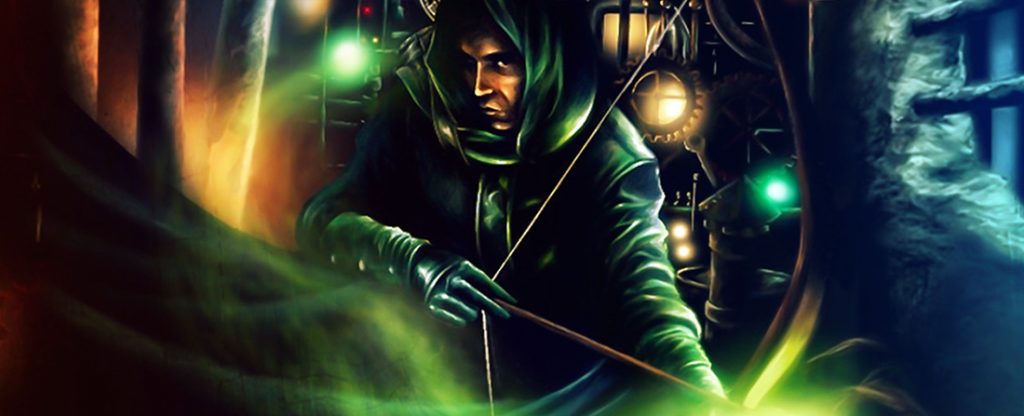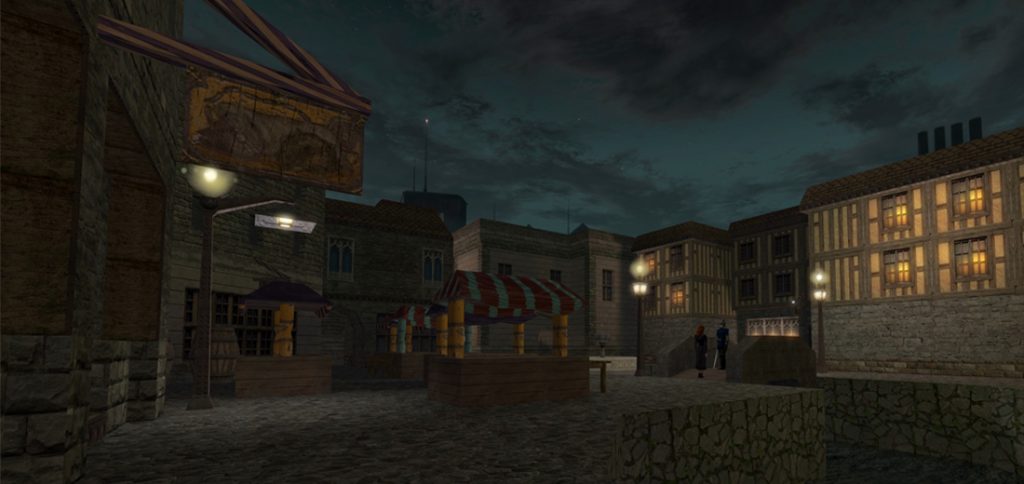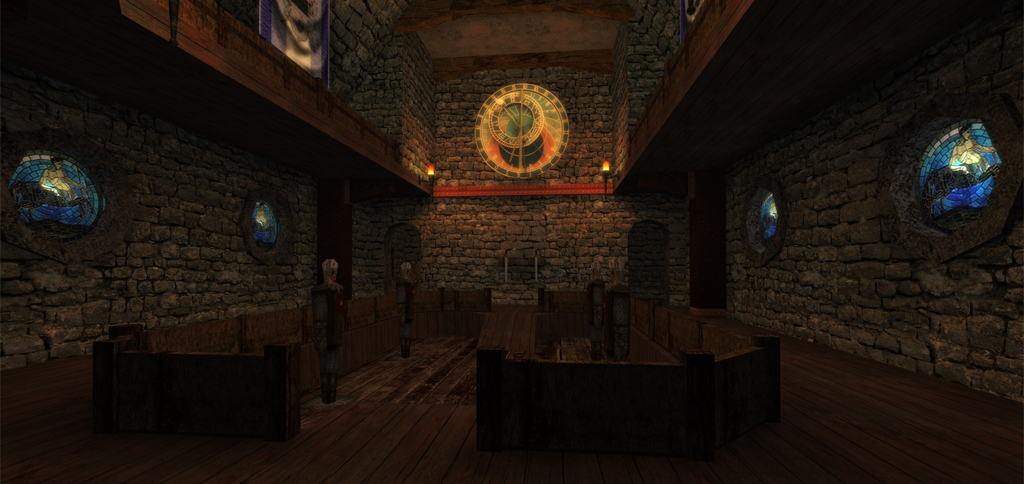Thief II: The Metal Age is the sequel to Thief: The Dark Project and the second game in the Thief series developed by Looking Glass Studios.

Utilizing the same Dark Engine that powered the original game, Thief II has an almost identical look and feel, with only minor graphical and programming improvements.
Navigation
I. Gameplay
II. Story
III. Development
IV. Reception
V. Walkthrough
Gameplay
The basic gameplay is fundamentally similar to the original Thief, with a few new elements, including technological gadgets such as a remote eye camera known as the Scouting Orb and more intelligent level designs. Other changes include an increase in the number of AI behaviors, and the addition of female guards and soldiers.
A new arrow type, the Vine Arrow, which can stick onto metal grates in addition to wooden surfaces, was added to replace Rope Arrows in a few missions. New potions were also added.
Responding to criticism of the original Thief, the missions in Thief II were designed much more around typical thief-like behavior, and much of the game is spent robbing the rich denizens of the City rather than raiding tombs and running from monsters, which was a common element in the first game.
In fact, the player encounters few of the monsters from the first Thief, except for Burrick heads mounted as trophies in some of the mansions as well as a few apebeasts, zombies, and Hammer Haunts.
The designers stated that unlike the original game, whose levels were developed to suit the plot, in Thief II the levels were designed first and the plot retrofitted to work with them. In general, the levels are much larger and less linear than those of its predecessor.

Story
The game begins as Garrett continues his life as a thief. However, he is betrayed by his fence and ambushed after an early mission, and he determines that Truart, the local sheriff, is hunting him.
Keepers take Garrett to hear a prophecy about the ‘Metal Age’, which he ignores. As Garrett leaves, Artemus, the Keeper who brought him into the order, informs him that Truart had been hired to kill him, and he gives Garrett a letter that directs him to eavesdrop on a Mechanist meeting.
There, Garrett overhears Truart and Father Karras discussing the conversion of street people into mindless ‘Servants’, who wear masks that emit a red vapor capable of reducing themselves and any nearby organic material to rust.
Truart promises to provide Karras with twenty victims for the Servant project, not realizing that Karras is recording his words for use in blackmail. Garrett steals the recording from a safe deposit box, in order to coerce Truart into revealing his employer.
However, Garrett finds Truart murdered at his estate. Evidence at the crime scene leads him to spy on the police officer Lt. Mosley. Garrett sees Mosley deliver a suspicious letter, which is carried through a portal by a wounded Pagan. Garrett enters the portal and finds himself outside the City, and he follows the pagan’s trail of blood to Viktoria, who persuades Garrett to join her against the Mechanists.
On a lead from Viktoria, he infiltrates Karras’ office to learn about the ‘Cetus Project’, and inadvertently discovers that Karras is giving Servants to the City’s Nobles. Garrett travels to a Mechanist base to find out more about the Cetus Project, which is revealed to be a submarine.
In order to locate and kidnap a high-ranking Mechanist named Brother Cavador, Garrett stows away in the vehicle. After delivering Cavador to Viktoria, Garrett steals a Servant mask to learn about a Mechanist technology called a ‘Cultivator’. Meanwhile, Karras hides inside the Mechanist cathedral in preparation for his plan. Garrett and Viktoria learn that it is the Cultivators inside Servant masks which emit ‘rust gas’.
Karras had provided Servants to Nobles with gardens in order to set off an apocalyptic chain reaction Viktoria plans to lure the Servants into the hermetically sealed Mechanist cathedral before Karras activates their masks, but Garrett believes this to be too dangerous and leaves.
Viktoria goes to the cathedral alone and dies while filling it with plants, and Garrett completes her plan, killing Karras in the rust gas. Afterward, Garrett is approached by Artemus, who explains that Karras’ scheme and Viktoria’s death had been prophesied. Garrett demands to know the rest of the Keepers’ prophecies as the game ends.

Development
Looking Glass Studios began designing the sequel in January 1999. It would be significantly more focused on stealth and forgo the swordplay of the original. The team also decided to scale back the maze-like levels and monsters in favor of urban environments and human enemies.
It was built with the third iteration of the Dark Engine, used previously for Thief: The Dark Project and System Shock 2. This meant that the character models were given close to double the polygons of those in the original game.
In addition, certain AI routines were implemented which allowed enemies to notice open doors or missing objects. Weather effects such as fog and rain were also added and the game’s skybox was drastically improved thanks to the studio’s work on Flight Unlimited.
The game was announced during E3 on May 13, 1999 where the team revealed its new direction and a release date of spring 2000. Plans to include a cooperative multiplayer mode were also detailed at the show.
By July, the team had begun building levels. Their emphasis on stealth led them to diversify the sequel’s missions with varied objectives like kidnapping, blackmailing, and eavesdropping.
While the first Thief’s levels were designed around an established story, the Thief II team opted to design levels first then craft a plot to weave them together. As a result, they often found it challenging to unite the two.
As Thief II’s development continued, Looking Glass was experiencing financial troubles, and by October 1999 the team cut the game’s multiplayer feature. The game would enter beta in January 2000, but the team fell behind and began working longer hours to make up for the loss.
By February, they were pushing themselves to their breaking point. Nevertheless, they met their deadline and Eidos expedited their payment for completing the game. Unfortunately, delayed royalties resulted in it being the last title the studio would publish before having to close in May 2000.
Reception
Thief II: The Metal Age was released on March 23, 2000. By November its global sales surpassed 220,000 copies. The game debuted high on the bestsellers list for computer games, and its initial sales were better than those of Thief: The Dark Project. It also received positive reviews from critics, with an aggregate score of 87/100 on Metacritic.
Computer Gaming World wrote that “everything in Thief II is bigger, sharper, better, and more effective” than in its predecessor. They enjoyed its story and called its levels “vast and intricate”, with “astonishingly complex and often beautiful” architecture, but found the game’s graphics lacking.
PC Gamer considered the game to be “more focused and polished than the original” and praised the removal of “zombie battles”. While they faulted its graphics, they summarized it as “one hell of a good game”.
Walkthrough
For a text walkthrough head over to the Keeper’s Chapel or download the strategy guide. For a guided video playthrough check out this playlist.
